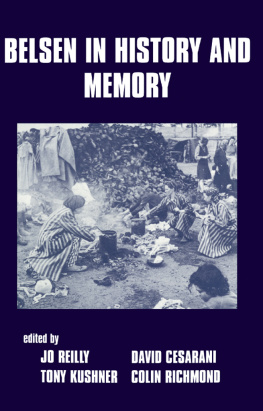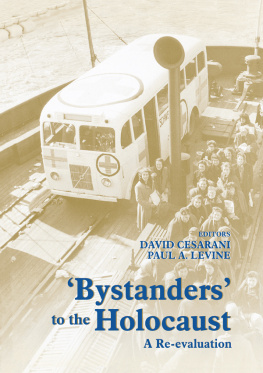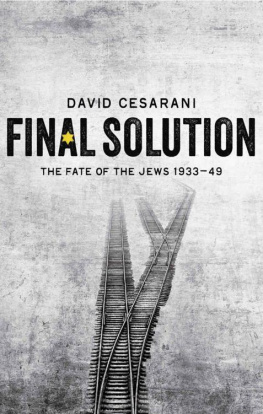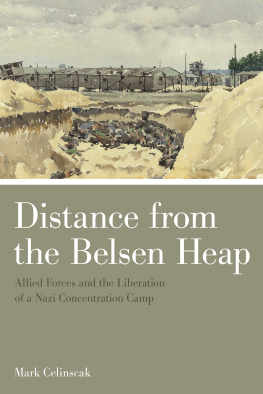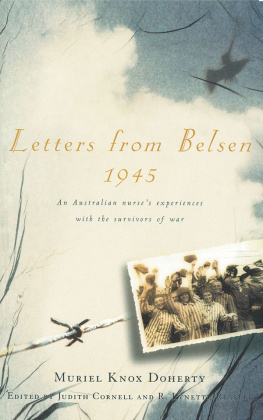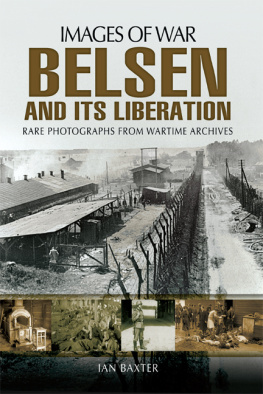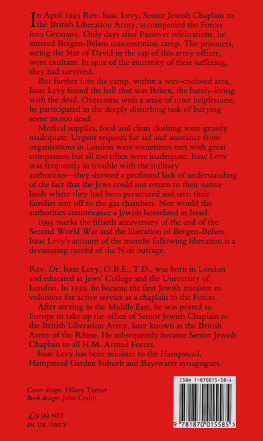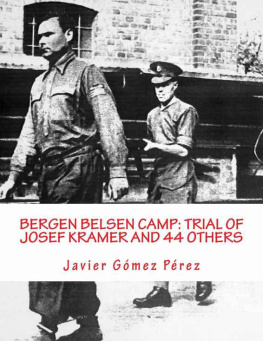BELSEN IN HISTORY AND MEMORY To the Memory of Hugo Gryn (19301986)
BELSEN IN
HISTORY AND
MEMORY
edited by
JO REILLY
DAVID CESARANI
TONY KUSHNER
COLIN RICHMOND
First published in 1997 in Great Britain by
FRANK CASS & CO. LTD.
Crown House, 47 Chase Side, Southgate
London N14 5BP
and in the United States of America by
FRANK CASS
c/o ISBS, 5824 N.E. Hassalo Street,
Portland, Oregon 97213-3644
Copyright 1997 Frank Cass & Co. Ltd. Reprinted 2001
British Library Cataloguing in Publication Data
A catalogue record for this book is available from the British Library
ISBN 0 7146 4767 5 (cloth)
0 7146 4323 8 (paperback)
ISBN 978 1 1352 5137 6 (ePub)
Library of Congress Cataloging-in-Publication Data
A catalog record for this book is available from the Library of Congress
All rights reserved. No part of this publication may be reproduced in any form, or by any means, electronic, mechanical, photocopying, recording or otherwise, without the prior permission of Frank Cass & Company Limited.
Printed & bound by Antony Rowe Ltd, Eastbourne
Contents
| Tony Kushner, |
| David Cesarani, |
| Jo Reilly and |
| Colin Richmond |
| Christine Lattek |
| Richard Breitman |
| Thomas Rahe |
| Annette Wieviorka |
| Paul Kemp |
| Jo Reilly |
| Hagit Lavsky |
| Tony Kushner |
between pages 121 and 122
| The notice erected by the British at the Entrance to Camp I (Jo Reilly) |
| Female internees preparing food in Camp I after liberation. In the background is a huge pile of boots and shoes (Wiener Library) |
| One of the mass graves marked by the British (Jo Reilly) |
| Inside the Human Laundry: an internee is washed before being transferred to Camp II (Wiener Library) |
| The Panzer Training School, one-and-a-half miles from Camp I, established by the British as a hospital centre and known as Camp II (Jo Reilly) |
| An ambulance of the Jewish Relief Team from Britain (Wiener Library) |
| Young mother in Belsen Displaced Persons Camp (Jewish Relief Unit Archive, Wiener Library) |
| The unveiling of the Jewish memorial stone on the site of Camp I, April 1946 (Wiener Library) |
| Children recovering in Belsen Displaced Persons Camp (Jewish Relief Unit Archives, Wiener Library) |
This volume grew out of a conference on The Liberation of Belsen held in London on 910 April 1995. The conference was organised jointly by Dr David Cesarani, Director of the Institute of Contemporary History and Wiener Library, London and Dr Tony Kushner, Marcus Sieff Lecturer in the Department of History and Parkes Library, University of Southampton. The administrative arrangements were ably handled by Anne Beale and Gerta Regensburger of the Wiener Library. The conference was sponsored by the Lord Ashdown Settlement; The R.M. Burton Charitable Settlement; Mr Ernst Fraenkel; Friends of the Parkes Library; Mr Jack Goldhill; The Sue Hammerson Foundation; The Hartley Institute and the School of Research and Graduate Studies, University of Southampton; Sir Sigmund Sterberg Charitable Foundation. The editors of this volume wish to tank these sponsors for making possible the event and the publication based on it. They also wish to thank Frank Cass who maintained his patient support for the project and Sybil Lunn who worked on the index. Rabbi Hugo Gryn, who died in 1996, closed the conference. This volume is intended as a small memorial and tribute to his courage and wisdom, and the inspiration he provided to all those concerned to increase knowledge and awareness of the Holocaust.
Approaching Belsen: An
Introduction
I
In a century that has witnessed ever-increasing opportunities for voyeurism, the liberation of Bergen-Belsen concentration camp by British forces in April 1945 has special significance. Although Nazi camps of a far more murderous nature were liberated before Belsen, the scenes recorded at Belsen by the soldiers, journalists, photographers, broadcasters and film crews were perhaps the most gruesome of all images relating to Nazi atrocities. The impact on those carrying out the liberation of Belsen, as will be stressed throughout this volume, was traumatic. Yet even those in the comfort of the cinemas, front rooms and libraries of the Home Front exposed to the newsreels, press and radio reports were left in a state of emotional shock by the attempts to communicate the horror of Belsen. Susan Sontag relates how in a Santa Monica bookstore she came across photographs from Bergen-Belsen and Dachau in July 1945:
Nothing I have seen in photographs or in real life ever cut me as sharply, deeply, instantaneously. Indeed, it seems plausible to me to divide my life into two parts, before I saw those photographs (I was twelve) and after, though it was several years before I understood fully what they were about [editors emphasis].
As a young child growing up in the United States, Sontags lack of wider context in which to place these photographed atrocities is neither surprising nor unusual. But her simplistic comment as late as
From the last months of 1994 through to the VE Day celebrations in May 1995, brief film clips and photographs from Belsen frequently framed media representations of the Second World War in its last stages and the Holocaust as a whole. The lack of sensitivity in the use of such images (and in particular specific scenes such as the bulldozing of dead bodies into the mass graves of Belsen) was indicative of the failure to understand, or in any way to confront, the complexity of what was actually being portrayed. The feelings, for example, of survivors in relation to these images was overshadowed by the desire to communicate other messages. The repugnant figures were being reproduced to show the nature of Nazism (and therefore, the reflected decency of the western Allies), rather than the immeasurable damage caused to the Jewish people and others in Europe.
Such representation echoed that of 50 years earlier when the horror images were shown as part of a formal and informal attempt against collective amnesia. Thus LEST WE FORGET: THE HORROR OF NAZI CONCENTRATION CAMPS REVEALED FOR ALL TIME IN THE MOST TERRIBLE PHOTOGRAPHS EVER PUBLISHED, compiled by the Daily Mail and mass-circulated in the early summer of 1945 reproduced image after image so as to maintain the loathing for all that Hitler and the Nazis represented. The book was a constant reminder to the British people of the menace they have beaten. The hundreds of photographs of the victims were accompanied by captions such as Wrecks of Humanity. The survivors were contrasted with the demonic SS men and women of the camp and were represented as merely an example of their
Who were these victims? In LEST WE FORGET, as in so much else of the instant atrocity material of 1945, they were simply identified through the concentration camp in which they had been liberated there are no names, personal histories or anything else that would undermine their use merely as illustrators of the true nature of Nazism. In 1958, the French government attempted to remove the remains of its own nationals from Belsen with the intention of re-interring them in France. The response of Brigadier Glyn Hughes, Chief British Medical Officer at Belsen was clear:


